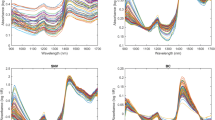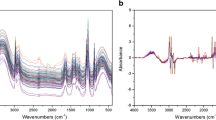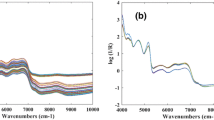Abstract
The extraction conditions applied in destructive analysis of Hibiscus sabdariffa L. (Hs) matrices before the measurement of antioxidant compounds may reduce their activities during isolation and purification due to decomposition. Hence, near infrared spectroscopic system was applied to determine these compounds. The calibration models developed by using partial least squares regression (PLSR) with 48 Hs samples and 24 unknown samples were used to confirm the robustness of the developed model. The results of calibration models effectively allowed the determination of the concentrations of total phenol content (TPC), total flavonoid content (TFC), total antioxidant content (TAC), ferric reducing antioxidant power (FRAP), and 1,1-diphenyl-2-picrylhydrazyl (DPPH) with high correlation coefficients (0.85–0.91) and small standard error of cross-validation (RMSECV) ranged from 0.08 to 0.33. The prediction capacity (RPD) for TPC, TFC, TAC, FRAP, and DPPH ranged from 3.30 to 8.25, thus demonstrating that the near infrared spectroscopic (NIRS) equations developed were applicable to unknown samples. This study demonstrates that NIRS can be considered as a fast tool for the nondestructive determination of antioxidant compounds (phenolics and flavonoids) and antioxidant activity of the Hs.



Similar content being viewed by others
References
Benzie IFF, and Strain JJ (1999) [2] Ferric reducing/antioxidant power assay: direct measure of total antioxidant activity of biological fluids and modified version for simultaneous measurement of total antioxidant power and ascorbic acid concentration. Methods in Enzymology. P. Lester, Academic Press. Volume 299: 15-27
Borrás-Linares I, Fernández-Arroyo S, Arráez-Roman D, Palmeros-Suárez PA, Del Val-Díaz R, Andrade-Gonzáles I, Fernández-Gutiérrez A, Gómez-Leyva JF, Segura-Carretero A (2015) Characterization of phenolic compounds, anthocyanidin, antioxidant and antimicrobial activity of 25 varieties of Mexican Roselle (Hibiscus sabdariffa). Ind Crop Prod 69:385–394
Çelik SE, Özyürek M, Güçlü K, Apak R (2010) Determination of antioxidants by a novel on-line HPLC-cupric reducing antioxidant capacity (CUPRAC) assay with post-column detection. Anal Chim Acta 674(1):79–88
Chen Q, Zhao J, Liu M, Cai J, Liu J (2008) Determination of total polyphenols content in green tea using FT-NIR spectroscopy and different PLS algorithms. J Pharm Biomed Anal 46(3):568–573
Chen L, Wang J, Ye Z, Zhao J, Xue X, Heyden YV, Sun Q (2012a) Classification of Chinese honeys according to their floral origin by near infrared spectroscopy. Food Chem 135(2):338–342
Chen Q, Ding J, Cai J, Zhao J (2012b) Rapid measurement of total acid content (TAC) in vinegar using near infrared spectroscopy based on efficient variables selection algorithm and nonlinear regression tools. Food Chem 135(2):590–595
Chen Q, Zhang D, Pan W, Ouyang Q, Li H, Urmila K, Zhao J (2015) Recent developments of green analytical techniques in analysis of tea’s quality and nutrition. Trends Food Sci Technol 43(1):63–82
Corbella E, Cozzolino D (2006) Classification of the floral origin of Uruguayan honeys by chemical and physical characteristics combined with chemometrics. LWT–Food Sci Technol 39(5):534–539
Da-Costa-Rocha I, Bonnlaender B, Sievers H, Pischel I, Heinrich M (2014) Hibiscus sabdariffa L.—a phytochemical and pharmacological review. Food Chem 165:424–443
Escuredo O, Carmen Seijo M, Salvador J, Inmaculada González-Martín M (2013) Near infrared spectroscopy for prediction of antioxidant compounds in the honey. Food Chem 141(4):3409–3414
Fan S, Huang W, Guo Z, Zhang B, and Zhao C (2015) Prediction of soluble solids content and firmness of pears using hyperspectral reflectance imaging. Food Analytical Methods: 1-11
Finkel T, Holbrook NJ (2000) Oxidants, oxidative stress and the biology of ageing. Nature 408(6809):239–247
Gökmen V, Serpen A, Fogliano V (2009) Direct measurement of the total antioxidant capacity of foods: the ‘QUENCHER’ approach. Trends Food Sci Technol 20(6–7):278–288
González-Martín M, Severiano-Pérez P, Revilla I, Vivar-Quintana A, Hernández-Hierro J, González-Pérez C, Lobos-Ortega I (2011) Prediction of sensory attributes of cheese by near-infrared spectroscopy. Food Chem 127(1):256–263
He H-J, Sun D-W, Wu D (2014) Rapid and real-time prediction of lactic acid bacteria (LAB) in farmed salmon flesh using near-infrared (NIR) hyperspectral imaging combined with chemometric analysis. Food Res Intl 62:476–483
Helland IS, Næs T, Isaksson T (1995) Related versions of the multiplicative scatter correction method for preprocessing spectroscopic data. Chemom Intell Lab Syst 29(2):233–241
Huang L, Wu D, Jin H, Zhang J, He Y, Lou C (2011) Internal quality determination of fruit with bumpy surface using visible and near infrared spectroscopy and chemometrics: a case study with mulberry fruit. Biosyst Eng 109(4):377–384
Kamruzzaman M, ElMasry G, Sun D-W, Allen P (2013) Non-destructive assessment of instrumental and sensory tenderness of lamb meat using NIR hyperspectral imaging. Food Chem 141(1):389–396
Luypaert J, Zhang MH, Massart DL (2003) Feasibility study for the use of near infrared spectroscopy in the qualitative and quantitative analysis of green tea, Camellia sinensis (L.). Anal Chim Acta 478(2):303–312
Mahomoodally MF (2013) Traditional medicines in Africa: an appraisal of ten potent African medicinal plants. Evid Based Complement Alternat Med 2013
Mata Sánchez J, Pérez Jiménez JA, Díaz Villanueva MJ, Serrano A, Núñez N, López Giménez J (2015) Assessment of near infrared spectroscopy for energetic characterization of olive byproducts. Renew Energy 74:599–605
Mohd-Esa N, Hern FS, Ismail A, Yee CL (2010) Antioxidant activity in different parts of roselle (Hibiscus sabdariffa L.) extracts and potential exploitation of the seeds. Food Chem 122(4):1055–1060
Moncada GW, González Martín MI, Escuredo O, Fischer S, Míguez M (2013) Multivariate calibration by near infrared spectroscopy for the determination of the vitamin E and the antioxidant properties of quinoa. Talanta 116:65–70
Nicolaï BM, Beullens K, Bobelyn E, Peirs A, Saeys W, Theron KI, Lammertyn J (2007) Nondestructive measurement of fruit and vegetable quality by means of NIR spectroscopy: a review. Postharvest Biol Technol 46(2):99–118
Noor N, Sarfraz RA, Ali S, Shahid M (2014) Antitumour and antioxidant potential of some selected Pakistani honeys. Food Chem 143:362–366
Pan L, Lu R, Zhu Q, McGrath JM, Tu K (2015) Measurement of moisture, soluble solids, sucrose content and mechanical properties in sugar beet using portable visible and near-infrared spectroscopy. Postharvest Biol Technol 102:42–50
Prenesti E, Berto S, Daniele PG, Toso S (2007) Antioxidant power quantification of decoction and cold infusions of Hibiscus sabdariffa flowers. Food Chem 100(2):433–438
Ramirez‐Rodrigues MM, Plaza ML, Azeredo A, Balaban MO, Marshall MR (2011) Physicochemical and phytochemical properties of cold and hot water extraction from Hibiscus sabdariffa. J Food Sci 76(3):C428–C435
Rhodes M (1996) Physiologically-active compounds in plant foods: an overview. Proc Nutr Soc 55(1B):371–384
Rice-Evans C, Miller N, Paganga G (1997) Antioxidant properties of phenolic compounds. Trends Plant Sci 2(4):152–159
Saxena S, Gautam S, Sharma A (2010) Physical, biochemical and antioxidant properties of some Indian honeys. Food Chem 118(2):391–397
Sáyago-Ayerdi SG, Arranz S, Serrano J, Goñi I (2007) Dietary fiber content and associated antioxidant compounds in roselle flower (Hibiscus sabdariffa L.) beverage. J Agric Food Chem 55(19):7886–7890
Shao Y, Xie C, Jiang L, Shi J, Zhu J, He Y (2015) Discrimination of tomatoes bred by spaceflight mutagenesis using visible/near infrared spectroscopy and chemometrics. Spectrochim Acta, Part A 140:431–436
Sharma R (2014) Chapter 59—Polyphenols in health and disease: practice and mechanisms of benefits. Polyphenols in human health and disease. R. R. Watson, V. R. Preedy and S. Zibadi. San Diego, Academic Press: 757-778
Sharma OP, Bhat TK (2009) DPPH antioxidant assay revisited. Food Chem 113(4):1202–1205
Sindi HA, Marshall LJ, Morgan MR (2014) Comparative chemical and biochemical analysis of extracts of Hibiscus sabdariffa. Food Chem 164:23–29
Singleton V, Orthofer LR, and Lamuela-Raventós RM (1999) [14] Analysis of total phenols and other oxidation substrates and antioxidants by means of Folin-Ciocalteu reagent. Methods in Enzymology. P. Lester, Academic Press. Volume 299: 152-178
Tabart J, Kevers C, Pincemail J, Defraigne J-O, Dommes J (2009) Comparative antioxidant capacities of phenolic compounds measured by various tests. Food Chem 113(4):1226–1233
Umar I, Maryoms N, Daikwo E, Gidado A, Buratai L, Igbokwe I, Ibrahim M (2009) The effect of aqueous extracts of Hibiscus sabdariffa (sorrel) calyces on heamatological profile and organ pathological changes in Trypanasoma congolense-infected rat. Afr J Tradis Complement Alternat Med 6(4)
Uprety Y, Asselin H, Dhakal A, Julien N (2012) Traditional use of medicinal plants in the boreal forest of Canada: review and perspectives. J Ethnobiol Ethnomed 8(7):14
Williams PC, and Sobering D (1996) How do we do it: a brief summary of the methods we use in developing near infrared calibrations. Near infrared spectroscopy: The future waves: 185-188.
Wold S, Sjöström M, Eriksson L (2001) PLS-regression: a basic tool of chemometrics. Chemom Intell Lab Syst 58(2):109–130
Woodcock T, Downey G, O’Donnell CP (2009) Near infrared spectral fingerprinting for confirmation of claimed PDO provenance of honey. Food Chem 114(2):742–746
Wu JG, Shi C, Zhang X (2002) Estimating the amino acid composition in milled rice by near-infrared reflectance spectroscopy. Field Crops Res 75(1):1–7
Wu D, Nie P, He Y, Bao Y (2012) Determination of calcium content in powdered milk using near and mid-infrared spectroscopy with variable selection and chemometrics. Food Bioproc Technol 5(4):1402–1410
Xiaowei H, Xiaobo Z, Jiewen Z, Jiyong S, Xiaolei Z, Holmes M (2014) Measurement of total anthocyanins content in flowering tea using near infrared spectroscopy combined with ant colony optimization models. Food Chem 164:536–543
Zhishen J, Mengcheng T, Jianming W (1999) The determination of flavonoid contents in mulberry and their scavenging effects on superoxide radicals. Food Chem 64(4):555–559
Acknowledgments
Authors acknowledged the National Science and Technology support program (2015BAD17B04), the Jiangsu Province Science Fund for Distinguished Young Scholars (BK20130010), and New Century Excellent Talents in University (NCET-11-0986).
Conflict of Interest
Haroon Elrasheid Tahir declares that he has no conflict of interest. Zou Xiaobo declares that he has no conflict of interest. Shi Jiyong declares that he has no conflict of interest. Abdalbasit A. Mariod declares that he has no conflict of interest. Tchabo Wiliam declares that he has no conflict of interest.
Compliance with Ethics Requirements
This article does not contain any studies with human or animal subjects.
Informed Consent
Informed consent is not applicable in this study.
Author information
Authors and Affiliations
Corresponding author
Rights and permissions
About this article
Cite this article
Tahir, H.E., Xiaobo, Z., Jiyong, S. et al. Rapid Determination of Antioxidant Compounds and Antioxidant Activity of Sudanese Karkade (Hibiscus sabdariffa L.) Using Near Infrared Spectroscopy. Food Anal. Methods 9, 1228–1236 (2016). https://doi.org/10.1007/s12161-015-0299-z
Received:
Accepted:
Published:
Issue Date:
DOI: https://doi.org/10.1007/s12161-015-0299-z




